高考英语阅读理解-推理判断题解题技巧
- 格式:ppt
- 大小:1.74 MB
- 文档页数:61
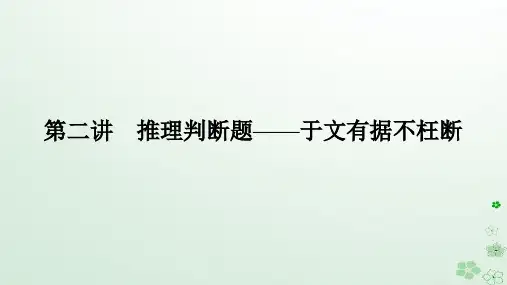
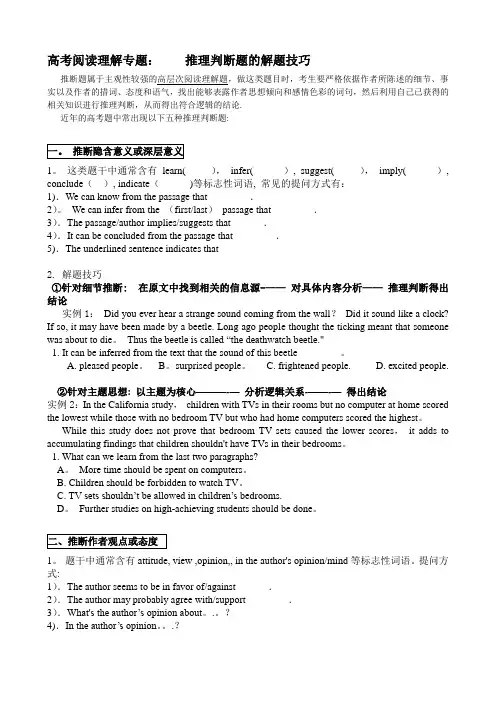
高考阅读理解专题:推理判断题的解题技巧推断题属于主观性较强的高层次阅读理解题,做这类题目时,考生要严格依据作者所陈述的细节、事实以及作者的措词、态度和语气,找出能够表露作者思想倾向和感情色彩的词句,然后利用自己已获得的相关知识进行推理判断,从而得出符合逻辑的结论.近年的高考题中常出现以下五种推理判断题:1。
这类题干中通常含有learn( ),infer( ), suggest( ),imply( ), conclude(), indicate()等标志性词语, 常见的提问方式有:1).We can know from the passage that ________.2)。
We can infer from the (first/last)passage that ________.3).The passage/author implies/suggests that ______.4).It can be concluded from the passage that ________.5).The underlined sentence indicates that ________2. 解题技巧①针对细节推断: 在原文中找到相关的信息源-——对具体内容分析——推理判断得出结论实例1:Did you ever hear a strange sound coming from the wall?Did it sound like a clock? If so, it may have been made by a beetle. Long ago people thought the ticking meant that someone was about to die。
Thus the beetle is called “the deathwatch beetle."1. It can be inferred from the text that the sound of this beetle ________。
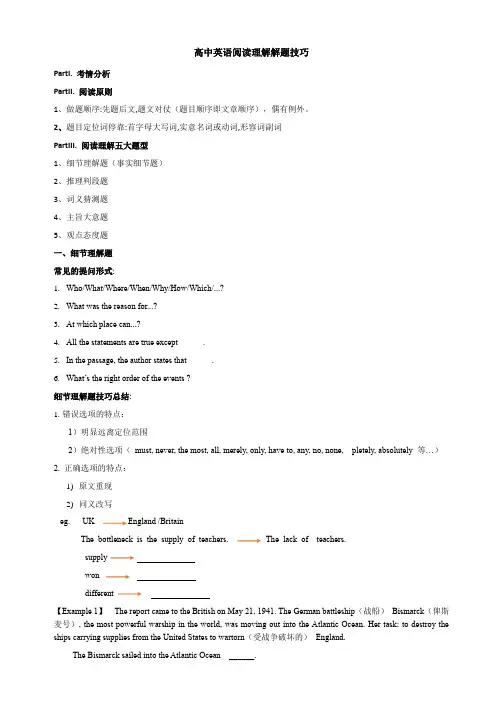
高中英语阅读理解解题技巧PartI. 考情分析PartII. 阅读原则1、做题顺序:先题后文,题文对仗(题目顺序即文章顺序),偶有例外。
2、题目定位词停靠:首字母大写词,实意名词或动词,形容词副词PartIII. 阅读理解五大题型1、细节理解题(事实细节题)2、推理判段题3、词义猜测题4、主旨大意题5、观点态度题一、细节理解题常见的提问形式:1.Who/What/Where/When/Why/How/Which/...?2.What was the reason for...?3.At which place can...?4.All the statements are true except.5.In the passage, the author states that.6.What’s the right order of the events ?细节理解题技巧总结:1.错误选项的特点:1)明显远离定位范围2)绝对性选项(must, never, the most, all, merely, only, have to, any, no, none, pletely, absolutely 等…)2. 正确选项的特点:1)原文重现2)同义改写eg. UK England /BritainThe bottleneck is the supply of teachers. The lack of teachers.supplywondifferent【Example 1】The report came to the British on May 21, 1941. The German battleship(战船)Bismarck(俾斯麦号), the most powerful warship in the world, was moving out into the Atlantic Ocean. Her task: to destroy the ships carrying supplies from the United States to wartorn(受战争破坏的)England.The Bismarck sailed into the Atlantic Ocean ______.A. to sink the Hood(胡德号战舰)B. to gain control of FranceC. to cut off American supplies to BritainD. to stop British warships reaching Germany【Example 2】The report came to the British on May 21, 1941. The German battleship(战船)Bismarck(俾斯麦号), the most powerful warship in the world, was moving out into the Atlantic Ocean. Her task: to destroy the ships carrying supplies from the United States to wartorn(受战争破坏的)England.The British had feared such a task. No warships(战船)they had could match the Bismark(俾斯麦号)in speed or in firepower(火力). The Bismarck had eight 15inch guns(火炮)and 81 smaller guns. She could move at 30 nautical miles (海里) an hour. She was believed to be unsinkable(不沉的).Many people believed that the Bismarck was the most strongest one because she ______.A. was fast and powerfulB. had more men on boardC. was under Luetjens’ mandD. had bigger guns than other ships牛刀小试:【EX. 1】However, the British had to sink her. They force their best battleship Hood(胡德号战舰)to hunt down the Bismarck(俾斯麦号). On May 24, the Hood found the Bismarck.It was a meeting(会面)that the German mander(指挥官)did not want to see. His orders were to destroy the British ships that were carrying supplies, but to stay away from a fight with British warships.The battle didn’t last long. The Bismarck’s first torpedo (鱼雷) hit the Hood, which went down taking all but three of her 1, 419 men with her.We learn from the text that on 24 May ______.A. the British won the battle against the BismarckB. the Bismarck won the battle against the BritishC. the British gunfire damaged the Bismarck seriouslyD. the Bismarck succeeded in keeping away from the British【EX. 2】But in the fight, the Bismarck was slightly damaged . Her mander decided to run for repairs to France, which had at that time been taken by the Germans. The British force followed her. However, because of the Bismarck’s speed and the heavy fog, they lost sight of her.Her mander tried to sail(航行)to France in order to ______.A. have the ship repairedB. join the other GermansC. get help from the FrenchD. get away from the British二、推理判断题常见提问方式1.The passage implies (暗示) that_______.2.We can conclude (得出结论) from the passage that_____.3.Which of the following can be inferred (推论)?4.What is the tone (语气) of the author ?5.What is the purpose (目的) of this passage?6.The passage is intended to (倾向于) _____.7.Where would this passage most probably appear(出现)?8.The next paragraph would most probably deal with_______.9.At the end of this passage, the writer might continue to write _______.技巧点拨:1.推断隐含意义【Example 1】A buildityourself solar still(自制太阳能蒸馏器)is one of the best ways to obtain drinking water in areas where the liquid is not readily available…..The only ponents(成分)required, though, are a 5' ×5' sheet of clear(透明的)or slightly milky(略带乳白色的)plastic, six feet of plastic tube(试管), and a container(容器)—perhaps just a drinking cup —to catch the water. These pieces can be folded(折叠)into a neat little pack and fastened(系)on your belt(腰带).1.What do we know about the solar still (蒸馏器)from the first paragraph? ()A. It’s delicate(精致的).B. It’s expensive.C. It’s plex.D. It’s portable(便携的).推断隐含意义题技巧总结:①Scanning,找到相关信息点②Study reading,不但理解表层,而且要由表及里、由浅入深地分析③推理,以文中提供的信息为依据,结合常识,作出符合逻辑的推断2.推断写作目的【Example 1】It’s an amazing acplishment(成就)and one we cannot achieve without generous support from individuals, corporations(企业), and other social organizations(组织). Visit to find various ways you can support Pacific Science Center.1.What is the purpose of the last part of the text? ()A. To encourage supports.B. To advertise ing events.C. To introduce special exhibits.D. To tell about the Center’s history.推断写作目的题技巧总结1:找句来推断写作目的。

高中英语推理判断题解题技巧篇一:高考英语阅读理解推理判断题的解题技巧高考英语阅读理解推理判断题的解题技巧编辑点评:推理判断题要求考生根据文章提供的事实和线索进行逻辑推理,推断出没有提到的或者没有明说的事实或者可能发生的事实。
这类旨在考查考生透过词语的字面意义去理解的言外之意或弦外之音的能力,属深层理解题。
推理判断题要求考生根据文章提供的事实和线索进行逻辑推理,推断出没有提到的或者没有明说的事实或者可能发生的事实。
这类旨在考查考生透过词语的字面意义去理解的言外之意或弦外之音的能力,属深层理解题。
此类试题的设计常常包括infer, imply, suggest, conclude等词。
这类题的设问方式主要有:(1)We can infer from the passage that ______.(2)What can be inferred from the passage?(3)Which of the following can be inferred from the passage?(4)It can be inferred from Paragraph 3 that ______.(5)The author suggest in this passage that ______.(6)The writer implies that ______.(7)It can be inferred that ______.(8)It can be concluded from the passage that ______.(9)On the whole, we can conclude that ______.(10)From the text we can conclude that ______.(11)After reading the passage we may conclude that______.(12)What conclusion can be drawn from the passage?(13)The author is inclined to think that ______.(14)When the writer talks about..., what he really means is that______.(15)What's the writer's attitude towards...?(16)What's the author's feeling towards...?(17)In the writer's opinion...理解文段的隐含信息包括:推测或人物的观点、态度、意图、身份、情感,对或文段所涉及的人物、事件作出评价等,属于深层理解,是语言学习者必须具备的交际能力之一。
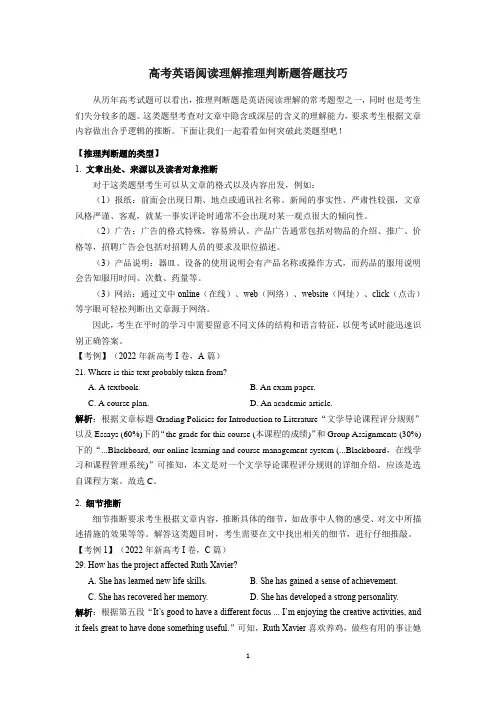
高考英语阅读理解推理判断题答题技巧从历年高考试题可以看出,推理判断题是英语阅读理解的常考题型之一,同时也是考生们失分较多的题。
这类题型考查对文章中隐含或深层的含义的理解能力,要求考生根据文章内容做出合乎逻辑的推断。
下面让我们一起看看如何突破此类题型吧!【推理判断题的类型】1. 文章出处、来源以及读者对象推断对于这类题型考生可以从文章的格式以及内容出发,例如:(1)报纸:前面会出现日期、地点或通讯社名称。
新闻的事实性、严肃性较强,文章风格严谨、客观,就某一事实评论时通常不会出现对某一观点很大的倾向性。
(2)广告:广告的格式特殊,容易辨认。
产品广告通常包括对物品的介绍、推广、价格等,招聘广告会包括对招聘人员的要求及职位描述。
(3)产品说明:器皿、设备的使用说明会有产品名称或操作方式,而药品的服用说明会告知服用时间、次数、药量等。
(3)网站:通过文中online(在线)、web(网络)、website(网址)、click(点击)等字眼可轻松判断出文章源于网络。
因此,考生在平时的学习中需要留意不同文体的结构和语言特征,以便考试时能迅速识别正确答案。
【考例】(2022年新高考I卷,A篇)21. Where is this text probably taken from?A. A textbook.B. An exam paper.C. A course plan.D. An academic article.解析:根据文章标题Grading Policies for Introduction to Literature“文学导论课程评分规则”以及Essays (60%)下的“the grade for this course (本课程的成绩)”和Group Assignments (30%)下的“...Blackboard, our online learning and course management system (...Blackboard,在线学习和课程管理系统)”可推知,本文是对一个文学导论课程评分规则的详细介绍,应该是选自课程方案。
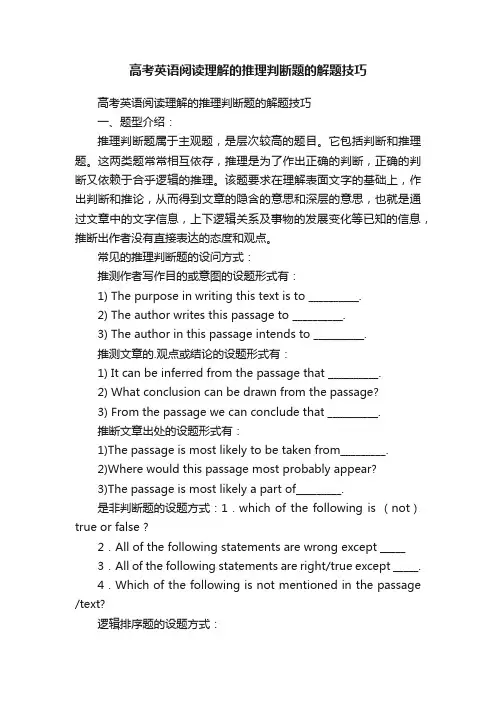
高考英语阅读理解的推理判断题的解题技巧高考英语阅读理解的推理判断题的解题技巧一、题型介绍:推理判断题属于主观题,是层次较高的题目。
它包括判断和推理题。
这两类题常常相互依存,推理是为了作出正确的判断,正确的判断又依赖于合乎逻辑的推理。
该题要求在理解表面文字的基础上,作出判断和推论,从而得到文章的隐含的意思和深层的意思,也就是通过文章中的文字信息,上下逻辑关系及事物的发展变化等已知的信息,推断出作者没有直接表达的态度和观点。
常见的推理判断题的设问方式:推测作者写作目的或意图的设题形式有:1) The purpose in writing this text is to __________.2) The author writes this passage to __________.3) The author in this passage intends to __________.推测文章的.观点或结论的设题形式有:1) It can be inferred from the passage that __________.2) What conclusion can be drawn from the passage?3) From the passage we can conclude that __________.推断文章出处的设题形式有:1)The passage is most likely to be taken from_________.2)Where would this passage most probably appear?3)The passage is most likely a part of_________.是非判断题的设题方式:1.which of the following is (not)true or false ?2.All of the following statements are wrong except _____3.All of the following statements are right/true except _____.4.Which of the following is not mentioned in the passage /text?逻辑排序题的设题方式:Which of the following describes one’s logic in doing sth ?Which of the following shows the correct order of what happened to …?Choose the right order of the following events in …二、推理判断题的解题方法:推理判断题不仅要求考生读懂文章中的每个句子的意思还要推理它们之间的关系,结合自己的生活常识和经验,再通过逻辑推理和判断,理解文章的言外之意,从而揭示文章的深层涵义。
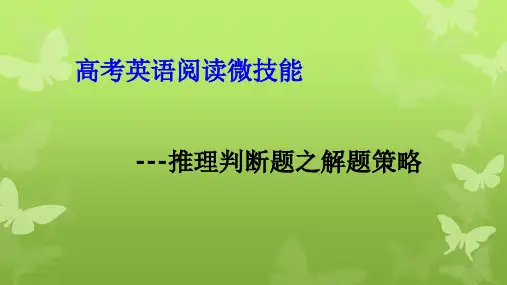
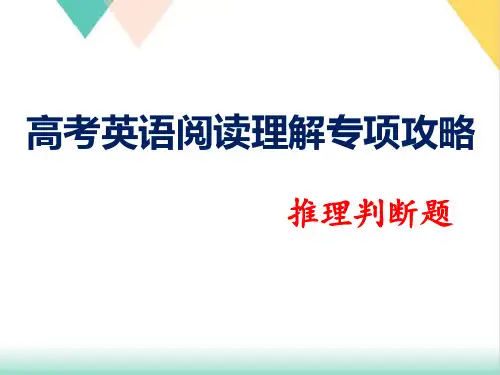
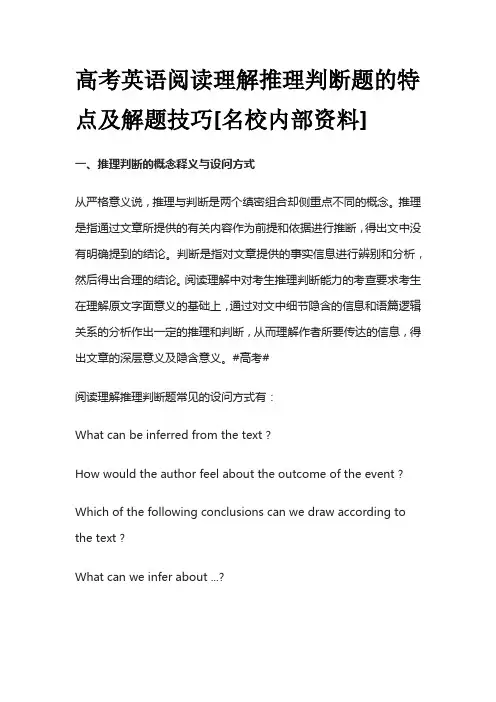
高考英语阅读理解推理判断题的特点及解题技巧[名校内部资料]一、推理判断的概念释义与设问方式从严格意义说,推理与判断是两个缜密组合却侧重点不同的概念。
推理是指通过文章所提供的有关内容作为前提和依据进行推断,得出文中没有明确提到的结论。
判断是指对文章提供的事实信息进行辨别和分析,然后得出合理的结论。
阅读理解中对考生推理判断能力的考查要求考生在理解原文字面意义的基础上,通过对文中细节隐含的信息和语篇逻辑关系的分析作出一定的推理和判断,从而理解作者所要传达的信息,得出文章的深层意义及隐含意义。
#高考#阅读理解推理判断题常见的设问方式有:What can be inferred from the text ?How would the author feel about the outcome of the event ?Which of the following conclusions can we draw according to the text ?What can we infer about ...?What can we know about the ... from the first paragraph ? What can we infer from the last paragraph ?What is the purpose of the last part of the text ?What is the author's purpose in writing the text ?What is the author's attitude to / toward the ...?Where might this passage be taken from ?What does the text imply ?Where can the text be found ?Where is the passage most likely to be taken from ?Where would this passage most probably appear ?二、推理判断题的细分题型特点及其解题技巧高考英语阅读理解推理判断题,根据考查的深层次内容,又可以再细分为“隐含意义推断题,观点态度推断题,写作意图推断题,文章出处或写作类型推断题和篇章结构推断题”5种小类型。
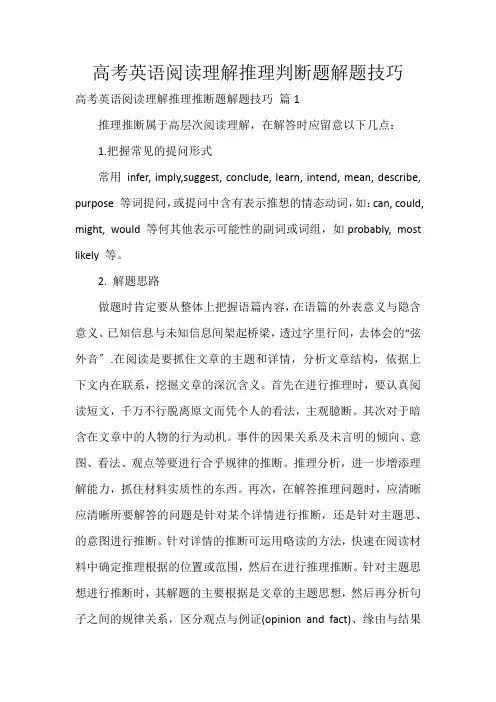
高考英语阅读理解推理判断题解题技巧高考英语阅读理解推理推断题解题技巧篇1推理推断属于高层次阅读理解,在解答时应留意以下几点:1.把握常见的提问形式常用infer, imply,suggest, conclude, learn, intend, mean, describe, purpose 等词提问,或提问中含有表示推想的情态动词,如:can, could, might, would 等何其他表示可能性的副词或词组,如probably, most likely 等。
2. 解题思路做题时肯定要从整体上把握语篇内容,在语篇的外表意义与隐含意义、已知信息与未知信息间架起桥梁,透过字里行间,去体会的“弦外音〞.在阅读是要抓住文章的主题和详情,分析文章结构,依据上下文内在联系,挖掘文章的深沉含义。
首先在进行推理时,要认真阅读短文,千万不行脱离原文而凭个人的看法,主观臆断。
其次对于暗含在文章中的人物的行为动机。
事件的因果关系及未言明的倾向、意图、看法、观点等要进行合乎规律的推断。
推理分析,进一步增添理解能力,抓住材料实质性的东西。
再次,在解答推理问题时,应清晰应清晰所要解答的问题是针对某个详情进行推断,还是针对主题思、的意图进行推断。
针对详情的推断可运用略读的方法,快速在阅读材料中确定推理根据的位置或范围,然后在进行推理推断。
针对主题思想进行推断时,其解题的主要根据是文章的主题思想,然后再分析句子之间的规律关系,区分观点与例证(opinion and fact)、缘由与结果(cause and effect),主观点与次观点(main idea and supporting idea)3.推理题的解题方法(1)抓住特定的信息进行逆向或正向推理做此类试题时,要擅长某一段话中的'关键信息,即某些关键词或短语去分析、推理推断,利用逆向思维或正向推理,从而推断出这句话所隐含的深层含义。
(2)整合全文(段)信息进行推断做推理题时,有时需要在弄懂全文意思的基础上,整合与题目相关的有用信息,综合起来进行推理推断,确定最正确结论。
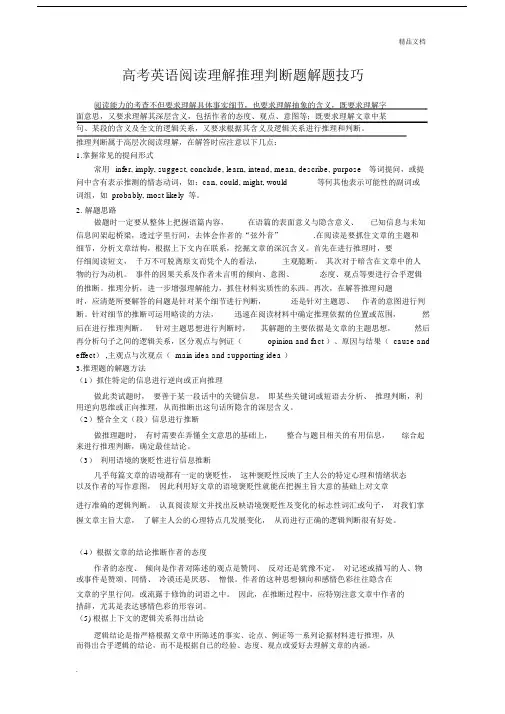
高考英语阅读理解推理判断题解题技巧阅读能力的考查不但要求理解具体事实细节,也要求理解抽象的含义,既要求理解字面意思,又要求理解其深层含义,包括作者的态度、观点、意图等;既要求理解文章中某句、某段的含义及全文的逻辑关系,又要求根据其含义及逻辑关系进行推理和判断。
推理判断属于高层次阅读理解,在解答时应注意以下几点:1.掌握常见的提问形式常用infer, imply, suggest, conclude, learn, intend, mean, describe, purpose等词提问,或提问中含有表示推测的情态动词,如:can, could, might, would等何其他表示可能性的副词或词组,如 probably, most likely 等。
2. 解题思路做题时一定要从整体上把握语篇内容,在语篇的表面意义与隐含意义、已知信息与未知信息间架起桥梁,透过字里行间,去体会作者的“弦外音”.在阅读是要抓住文章的主题和细节,分析文章结构,根据上下文内在联系,挖掘文章的深沉含义。
首先在进行推理时,要仔细阅读短文,千万不可脱离原文而凭个人的看法,主观臆断。
其次对于暗含在文章中的人物的行为动机。
事件的因果关系及作者未言明的倾向、意图、态度、观点等要进行合乎逻辑的推断。
推理分析,进一步增强理解能力,抓住材料实质性的东西。
再次,在解答推理问题时,应清楚所要解答的问题是针对某个细节进行判断,还是针对主题思、作者的意图进行判断。
针对细节的推断可运用略读的方法,迅速在阅读材料中确定推理依据的位置或范围,然后在进行推理判断。
针对主题思想进行判断时,其解题的主要依据是文章的主题思想,然后再分析句子之间的逻辑关系,区分观点与例证(opinion and fact )、原因与结果( cause and effect) ,主观点与次观点( main idea and supporting idea )3.推理题的解题方法(1)抓住特定的信息进行逆向或正向推理做此类试题时,要善于某一段话中的关键信息,即某些关键词或短语去分析、推理判断,利用逆向思维或正向推理,从而推断出这句话所隐含的深层含义。
阅读理解词义猜测篇解题技巧近几年来高考英语阅读理解非常注重对词义的推断题,代词指代判断题和生词词义判断题,其解题思路如下:一、由人称演变过程推断代词意义代词意义判断题要求考生借助诧境逻辑推断人称代词和指示代词的意义。
人称代词意义判断题主要考查考生对it,指动物、无生命事物、特定事件、人,,they,指复数人、动物、物品、事件,属主格,,them(指复数人、动物、物品、事件,属宾格),he, she等代词指代意义的推断。
指示代词意义判断题主要要求考生对this,these, that, those等代词指代意义进行准确判断,考查考生对特定人、物和事件的再认能力。
历年高考实践表明,代词意义判断题容易出现在人称转换较多和动作变换频繁的语境当中。
解题时考生应认真阅读特定代词所在句和前后邻句的内容,搞清人称转换和动作变换的过程,弄清其来龙去脉和前因后果,这样就能准确推断其所替代的对象。
常见的标志词有: mean, underlined, refer to常见的命题形式有:The underlined word in the second paragraph means “________”.Which of the following words is closest in meaning to the underlined word in the last paragraph?The underlined word “hunch” in Paragraph 2 can best be replaced by “________”.What does the phrase “knock off” in Paragraph 1 mean?The underlined sent ence in the last paragraph means “________”.The word “it” in the last sentence refers to “________”.例1:原文:We achieve knowledge passively by being told by someone else. Most of thelearning that takes place in the classroom and the kind that happens when we watch TV or read newspapers or magazines is passive. Conditioned as we are to passive learning, it’s not surprising that we depend on it in our everyday communication with friends and co-workers. (天津卷D卷)试题:The underlined word “it” in paragraph 2 r efers to ______(49题)A active learningB knowledgeC communicationD passive learning例2:原文:Photographs are everywhere. They decorate the walls of homes and are used in stores for sales of different goods. The news is filled with pictures of fires, floods, and special events. Photos record the beauties of nature. They can also bring things close that are far away. Through photos, people can see wild animals, cities in foreign lands, and even the stars in outer space. Photo also tell stories. (陕西卷B篇)试题:The underlined word “they” in the first paragraph refers to_____(45题)A beautiesB photosC goodsD events例3:原文:Tanni’s enduring success has been part motivation, part preparation. “The training I do that enables me to be a good sprinter(短跑运动员)enables me to be a good at a marathon too. I train 50 weeks of the year and that keeps me prepared for whatever distance I went to race------I am still competing at a very high level, but as I get older things get harder and I went to re tire before I fall apart.”(福建卷A篇)试题:The underlined word “that” in the 5th paragraph refers to_______(58题)A.fifty weeks’ trainingB.being a good sprinterC.training almost every dayD.part motivation and part preparation例4:原文:The next day my dad pulled out his childhood pictures and told me quite a few stories about his own childhood . Although our times together became easier over theyears, I never felt closer to him at that moment. After so many years, I’m at last seeing another side of my fath er. And in so doing, I’m delighted with my new friend. My dad, in his new home in Arizona, is back to me from where he was.(全国卷I ,篇)试题: The underlined words “my new friend” in the last paragraph refer to________(59题)A the author’s sonB the author’s fatherC the friend of the author’s fatherD the café owner例5:原文:Some politicians often use this trick. Let’s say that during Governor Smith’s last term, her state lost one million jobs and gained three million jobs. Then she seeks anot her term. One of her opponents says,“During Governor Smith’s term, the state lost one million jobs!”that’s true. However, and honest statement would have been, “During Governor Smith’s term, the state had a net gain of two million jobs”------(全国卷:篇)试题:Wh at do the underlined words “net gain” in paragraph 5 mean?(51题)A.final increaseB.big advantagerge shareD.total saving例6:原文:A Brown University sleep researcher has some advice for people who run high schools: Don’t start classes s o early in the morning. It may not be that the students who nod off at their desks are lazy. And it may not be that their parents have failed to enforce bedtime. Instead, it may be that biologically these sleepyhead students aren’t used to the early hour.------(08浙江卷C篇)试题:The underlined phrase “nod off”(paragraph1) most probably means“______”(49)题A.turn aroundB.agree with othersC.fall asleepD.refuse to work例7: 原文:be skeptical; the topmost branches are usually too skinny to hold weight, and we could never climb high enough to see anything except other trees.------(天津卷E篇) 试题:The underlined word“skeptical”in Paragraph 3 is closest in meaning to _______ (54题)A.clamB.doubtfulC.seriousD.optimistic例8:原文:Climbing attracts people because it’s good exercise for almosteveryone. You use your whole body a complete workout. When you climb,both your mind and your body can become stronger. (安徽卷:篇)试题:The word “workout” underlined in the last paragraph most prob ably means ________(66题)A.settlementB.exerciseC.excitementD.tiredness例9:原文: Parents who found older children bullying younger brothers and sisters might do well to replace shouting and punishment by rewarding and giving more attention to the injured ones. It’s certainly much easier and more effective.(湖北卷B篇)试题:According to the passage, the underlined word “bullying” is closest in meaning to “_________”(67题)A.helpingB.punishingC.hurtingD.protecting词义猜测题强化训练◆Car rentals (出租) are becoming more and more popular as an inexpensive way of taking to the roads.1. The underlined word “inexpensive” in the sentence is closest in meaning to _____.A. modernB. valuableC. convenientD. cheap◆Mr. Smith loves to talk, and his wife is similarly loquacious.2. The underlined word “loquacious” in the sentence probably means _____.A. quietB. calmC. activeD. talkative◆The old woman has a strange habit to keep over 100 cats in her house. Her neighbors all called her an eccentric lady.3. An eccentric lady is likely _____.A. to get along with easilyB. to be different from most peopleC. to be humor and lovelyD. to be serious and beloved◆Most women in Ghana — the educated and illiterate, the urban and rural, the young and old — work to earn an income in addition to maintaining their roles as housewives and mothers.4. The underlined word “illiterate” in the passage means _____.A. repeatedB. richC. uneducatedD. sick◆Dr. Barnard was a member of an agricultural mission to India, a group of experts on better farming methods.5. The underlined word “mission” in the sentence means _____.A. a group of workers working abroadB. a group of students studying abroadC. a group of tourists travelling in foreign countriesD. a group sent abroad to offer help to a foreign country◆Before the main business of a conference begins, the chairman usually makes a short preliminary speech, or makes a few preliminary remarks. In other words, he says a few things by way of introduction.6. What do the underlined words “preliminary speech” mean?A. A speech to give a brief introduction.B. A speech to make the atmosphere active.C. A speech to attract the attention of the listeners.D. A speech to make the listeners laugh.◆Music, for instance, was once as groups’ experience. ... For many people now, however, music is an individual experience.7. The underlined word “individual” probably means _____.A. specialB. personalC. seriousD. alone1-7 DDBCDAB。
高考英语阅读理解技巧点拨—推理判断题(一)题型复习阅读理解归纳为以下四大题型,根据阅读理解题考查角度的不同,可采用不同的解题技巧来应付。
Ⅰ.事实细节题Ⅱ.猜测词义题学会”顺藤摸瓜",通过构词,语法,定义,同位,对比,因果,常识,上下文等线索确定词义。
在阅读解题时要注意从以下七个方面着手:1)根据定义或解释、说明猜测生词的词义2)根据对比关系猜测生词的词义3)通过因果关系猜测词义4)根据生活常识猜测词义5)根据同等关系猜测词义6)根据列举的事例猜测词义7)根据构词法知识猜测词义Ⅲ.推理判断题做这类题要求考生在阅读理解整体语篇的同时,又要求学生对作者的态度、意图及文章细节的发展作正确的推理判断,力求从作者的角度去考虑,不要固守自己的看法或观点。
不要主观臆断,凭空想象,任意发挥,而走入误区。
学生要学会运用主题句去推测、揣摩文字背后作者的意图,运用归纳、对比、演绎技能,运用背景知识去挖掘文章深层含义,从而正确理解作者的言外之意,同时认真体会文章的语气与感情基调(如:否定、厌恶、反问、讽刺等).这类试题常以如下句式发问:①What can you conclude/ imply from this passage?②What’s the author's attitude(态度)towards.。
?③We can infer /learn from the passage that...Ⅳ.主旨大意题这种题型要求考生能够把握文章的总体,并真正理解主题和中心;要求能较好地运用概括、判断、归纳、推理等逻辑思维方法解题,难度较大,属于高层次题.一般主旨大意题可以分为两类:1.确定文章的标题和主题(title or topic)标题位于文章之首,用来高度概括文章内容,点明文章主题。
它可以是单词,短语,也可以是句子。
要确定文章标题,首先,要在阅读原文的基础上,考虑标题是否与主题密切相关;其次,看标题是否能概括全文内容。
高考英语阅读理解推理判断题的解题技巧高考英语阅读理解推理判断题的解题技巧导语:关于阅读能力的考查不但要求学生要理解具体事实细节,也要理解抽象的含义;既要理解字面意思,又要理解其深层含义,包括作者的态度、观点、意图等;既要求理解文章中某句、某段的含义及全文的逻辑关系,又要求根据其含义及逻辑关系进行判断和推理。
下面就由店铺为大家介绍高考英语阅读理解推理判断题的解题技巧,大家一起去学习吧!NMET中,推理判断题的考查每年都占阅读理解试题的一半左右。
推理判断试题属于高层次阅读理解题,很多考生对此类题型的解答感到很吃力,没有把握。
下面笔者结合近年高考试题,谈谈推理判断题的解题技巧,希望对大家复习备考有所帮助。
一、推理题常见的提问形式常以infer,imply,suggest,conclude,learn,intend,mean,describe,purpose等词提问。
或提问中含有表示推测的情态动词,如can,could,might,would等和其他表示可能性的动词,如probably,most likely等。
二、推理题的解题思路如何做好推理判断题?笔者以为,考生做题时一定要从整体上把握语篇内容,在语篇的表面意义与隐含意义、已知信息与未知信息间架起桥梁,透过字里行间,去体会作者的“弦外之音”。
首先,要求考生在阅读时,要抓住文章的主题和细节,分析文章结构,根据上下文内在联系,挖掘文章的深层含义。
在进行推理时,考生一定要仔细阅读短文,千万不可脱离原文而仅凭个人的看法,主观臆断。
其次,对于暗含在文章中的人物的'行为动机、事件的因果关系及作者未言明的倾向、意图、态度、观点等要进行合乎逻辑的判断、推理、分析,进一步增强理解能力,抓住材料实质性的东西。
再次,在解答推理性问题时,应清楚所要解答的问题是针对某个细节进行推断,还是针对主题思想、作者的意图进行推断。
针对细节的推断可运用scanning方法,迅速在阅读材料中确定推理依据的位置或范围,然后再进行推理判断。
高考英语阅读理解推理判断题的解题这类题属于主观题,是层次较高的设题。
它包括判断和推理题。
这两类题常常相互依存,推理是为了得出正确的判断,正确的判断又依赖于合乎逻辑的推理。
推理题要求在理解原文表面文字信息的基础上,做出一定判断和推论,从而得到文章的隐含意义和深层意义。
推理题所涉及的内容可能是文中某一句话,也可是某几句话,但做题的指导思想都是以文字信息为依据,既不能做出在原文中找不到文字根据的推理,也不能根据表面文字信息做多步推理。
所以,推理题的答案只能是根据原文表面文字信息一步推出的答案:即对原文某一句话或某几句话所作的同义改写(paraphrase)或综合。
常见的题干有:1) It can be inferred from the text that.2) We can conclude that.3) When the writer talks about..., what he really means is that.4) Which of the following can be inferred from the passage?判断题考查学生在理解文章的基础上,对不同观点进行评价和判断的能力。
推理题考查学生由文章的字面信息推出未知信息或隐含信息的能力。
1) 判断有据, 推论有理, 忠实原文。
切忌用自己的观点代替作者的本意。
2) 全面分析所有相关信息,切忌片面思考,得出片面结论。
3) 善于揣摩作者思路,尽可能与作者的思路吻合。
4)不可直接选取文中的原句。
例1: AnnealingAnnealing is a way of making metal softer by heating it and then letting it cool very slowly.If metal is heated and then cooled very quickly, for example by dipping (浸) it in water, it will bevery hard but also very brittle-that is, it will break easily. Metal that has been annealed is soft butdoes not break as easily. It is possible to make metal as hard or as soft as it is wished, by annealingit. The metal is heated, and allowed to cool slowly for a certain length of time. The longer theheated metal takes to cool slowly, the softer it becomes. Annealing can also be used on othermaterial, such as glass.(1990NMET)Why do people put hot metal in waterA. To make it hard.B. To make it soft.C. To make it cool.D. To make it brittle.[分析]答案为A,此题属推断归纳题。
题型02 推理判断题命题特点推理判断题是阅读理解中难度较大的题型。
它不仅要求考生理解文章的字面意思,还要对文章的表面信息进行挖掘,将作者在文中没有直接说出的意思通过对细节上的暗示和语篇逻辑关系的分析,做出一定判断和推理,从而得出文章的深层意义和隐含意义。
考查方向推理判断题在高考中占比很重,经常达到4-8题甚至以上,包括隐含意义推断题、观点态度推断题、文章出处或写作对象、目的意图推断题和下文预测推断题。
命题规律1.文中长复合句、特殊句型处常考2.语言转折和强对比处常考3.对文章中心思想处常考推理判断题干扰项特征命题点01 隐含意义推断题【典例】(2023·福建泉州·高三校考期中)IT’S A TYPICAL morning: you wake up, take a shower, brush your teeth, and then prick (刺; 扎) your arm with a tiny needle. Wait, what? Unless you have a serious disease such as diabetes, you probably haven’t ever tested your own blood. But in the future, that might change.The company Cor already sells a system for home blood testing. You stick your arm using a supposedly painless, one-off , blood-drawing cartridge (针筒) about the size of a lipstick. Then you stick the cartridge into a device that looks like the base for an electric toothbrush. A few minutes later, an app on your phone buzzes with updated information, including your current health data and tips on what to eat and how to exercise during the day. 5.Why does the author mention the typical morning in the first paragraph?A.To explain a scene.B.To introduce the topic.C.To make a comparison.D.To provide an example.洗个澡,刷牙,然后用一根小针刺伤你的手臂。